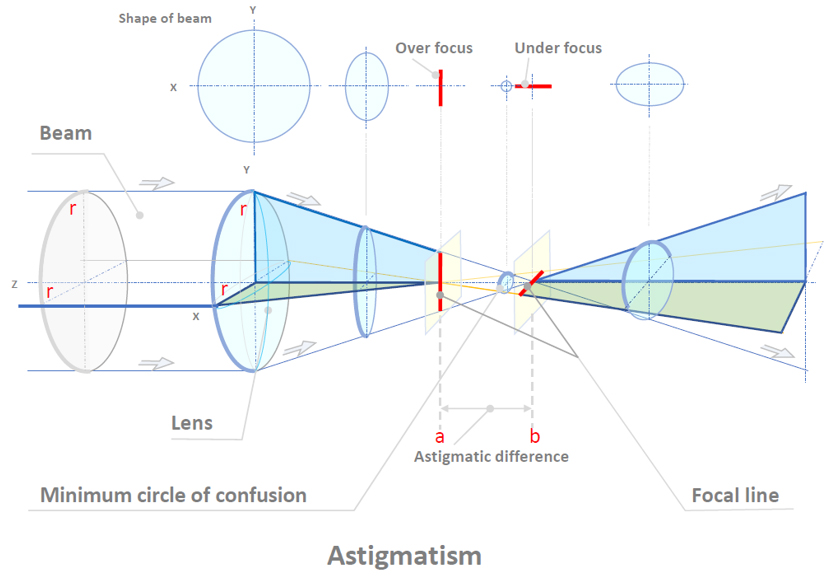非点収差
非点収差
astigmatism
[目次:理論]
電子線が電子レンズを通過するとき、光軸と直交する二つの軸上を通過する電子線の焦点位置が異なることによって発生する収差。
図1に示すように、電子線がレンズのX軸上で光軸からの距離rのところを通るとき、電子線は位置aに焦点 (オーバーフォーカスという) を結ぶ。他方、レンズのY軸上で光軸からの距離rのところを通る電子線は位置bに焦点 (アンダーフォーカスという) を結ぶ。そのため、電子線は、位置aではY軸方向に伸び、位置bではX軸方向に伸びる。位置aと位置bの距離を非点隔差という。非点収差を含んだ状態でも、最小錯乱円 (エグザクトフォーカス) が位置aと位置bの間に存在する。
非点収差は、レンズの軸対称性の崩れが原因で、レンズの材質の不均一性、機械加工及び組み立ての精度不足に由来する。ここで扱っている非点収差は、電子光学の理論上起こりうる非点収差 (ザイデルの5収差の中の非点収差) とは別のものである。 図2 (a-c) は非点収差があるときのSEM像である。(a) オーバーフォーカスと (c) アンダーフォーカスの位置では、互いに直交方向に焦点が合わない広がりを持った像になっている。(b) エグザクトフォーカスの位置では像の広がりが両方向で等しくなっている。ただし、像の輪郭はぼやけている。これは試料の1点から出射する電子線が、非点収差のために最小錯乱円の大きさより小さくならないからである。
非点収差は非点収差補正装置によって取り除くことができる。

図1 非点収差がある場合の光線図
レンズを通った電子線は、位置aではY軸方向に伸び、位置bではX軸方向に伸びる。位置aと位置bの距離を非点隔差という。非点収差を含んだ状態でも、位置aと位置bの間に最小錯乱円が存在する。

図2 非点収差がある場合に焦点位置を変えたときの像の変化。
非点収差があると、(a) オーバーフォーカスと (c) アンダーフォーカスで、直交する方向に像の広がり (矢印の方向へ像の広がり (ボケ) )が生じている。(b) エグザクトフォーカスでは、ボケの量は両方向で等しいが、試料の輪郭が明瞭な像を得ることはできない。
試料:スズのボール/Carbon pellet、加速電圧:5 kV、ワーキングディスタンス:4 mm、照射電流量:176 pA。
The astigmatism is an aberration which arises from the difference in the focal positions between the electron beams passing on two axes orthogonal to the optical axis when the beams pass through an electron lens.
As shown in Fig. 1, an electron beam which runs at a distance r on the X axis from the optical axis of the lens is focused at position a, which is in the front of the exact focus point (overfocus). On the other hand, an electron beam which runs at a distance r on the Y axis from the optical axis of the lens is focused at position b, which is at the rear of the exact focus point (underfocus). As a result, the electron beam forms a line in the Y direction at position a, but forms a line in the X direction at position b. The distance between the positions a and b is called the astigmatic difference. The minimum circle of confusion is produced between the positions a and b (at the original focus position) even astigmatism exists.
The astigmatism is caused by the axial asymmetry of the lens due to magnetic non-uniformity of the lens material and insufficient precision of machining and assembly. The astigmatism treated here is different from the off-axial astigmatism or one of Seidel’s five aberrations inherent to electron optics.
Fig. 2(a-c) show SEM images which contain the astigmatism. The SEM images taken at an overfocus position (a) and an underfocus position (c) show blur in the two orthogonal directions to each other. At the exact focus position (b), the image shows isotropic blur, which is because the electron beams emitted from one point of the specimen do not form a size smaller than the size of the minimum circle of confusion due to the astigmatism.
The astigmatism can be removed using a stigmator.

Fig. 1 Ray path of electron beams with astigmatism.
An electron beam passing through the lens forms a line in the Y direction at position a, but forms a line in the X direction at position b. The distance between the positions a and b is called the astigmatic difference. The minimum circle of confusion is formed between the positions a and b (at the original focus position) even astigmatism exists.
 Fig. 2 Image blur at different focal positions when the astigmatism exists (a-c).
Fig. 2 Image blur at different focal positions when the astigmatism exists (a-c).Image blur at an overfocus position (a) and an underfocus position (c) appears in the two orthogonal directions (indicated by arrows). At the exact focus position (b), image blur is isotropic.
Specimen: Ball of tin/Carbon pellet. Accelerating voltage: 5 kV. Working distance: 4 mm. Probe current: 176 pA.
関連用語から探す
説明に「非点収差」が含まれている用語






